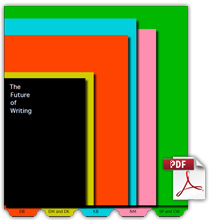The Future of Writing was a design project commisioned by Microsoft Research Cambridge and the Microsoft Office team, in the summer of 2011, from the Royal College of Art in London. In this project five teams of design alumni from the college took a speculative approach to looking at the way in which authorship may change in the future. The result is five very diverse design ideas and directions, described using video, text, images and interactive prototypes.
The following content is drawn from the project PDF (opens in new tab) designed and assembled by Kellenberger–White (opens in new tab). The PDF details this project in much greater depth than here, and includes reference material, process and thinking, images, links, inspiration and more.
The 5 projects described below are:
-
The Infinite Adventure Machine by David Benqué (opens in new tab).
-
Happily Ever After in the Big Society by Dash Macdonald and Demitrios Kargotis (opens in new tab).
-
How do I know what I think until I see what I say? by Koby Barhad (opens in new tab).
-
Punctuation? by Nicolas Myers (opens in new tab).
-
The Future of Everything by Sascha Pohflepp (opens in new tab) and Chris Woebken (opens in new tab).
-
Professor Anthony Dunne | Head of Programme, Design Interactions (opens in new tab)
“In this project with Microsoft Research, Cambridge, and the Microsoft Office Team, we explore new ways design can make technology-supported writing and authorship more meaningful and relevant to our lives, both now, and in the future, by thinking not only about new applications but implications as well.
The aim is to inspire, stimulate discussion, and provoke debate in order to help achieve a technological future that reflects the complex, troubled people we are, rather than the easily satisfied consumers and users we are supposed to be.”
Richard Banks, Alex Taylor and Tim Regan | Socio-Digital Systems (opens in new tab), Microsoft Research Cambridge.
“It’s clear that tools for reading and writing are evolving exponentially, with this year’s tweet replacing last year’s blog post. The danger here is that technology becomes the primary way through which authorship and consumption are defined. In this project, undertaken with the Royal College of Art in London, a number of world-class designers speculate beyond technology and functionality on the possibilities for authorship. From the material to the symbolic, the philosophical to the political, this thought-provoking body of work invites new questions on the forms and processes of literary creation.”
-
The Infinite Adventure Machine
by David Benqué (opens in new tab)
The Infinite Adventure Machine (TIAM) is a proposal for a computer program that generates fairy tale plots. Based on the work of Vladimir Propp, who reduced the structure of Russian folktales to 31 basic functions, TIAM aims to question the limitations and implications of attempts at programming language and narrative.
Because the program is unable to deliver a finished story, rather only a crude synopsis and illustrations, users have to improvise, filling the gaps with their imaginations and making up for the technology’s shortcomings.
View the project website (opens in new tab) (including video).

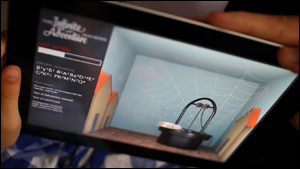
-
Happily Ever After in the Big Society
by Dash Macdonald and Demitrios Kargotis (opens in new tab)
‘Happily Ever After in the Big Society’ is a hyper-realistic workshop training script that uses fictional case studies to model and explore goals and objectives identified in the 2010 Conservative manifesto. Expanding on the misappropriation and exploitation of fiction in management training, the project questions whether it is possible to transpose ideas from iconic stories and films into real-world applications, and the socio-political implications of reworking fictional models to inform the contemporary grand narrative of ‘The Big Society’.
Download the Workshop Training Script (opens in new tab).

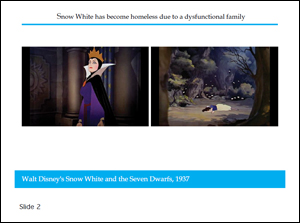
-
How do I know what I think until I see what I say?
by Koby Barhad (opens in new tab)
“How do I know what I think until I see what I say?” (E.M. Forster).“Thoughts you may have” is a research project that look into the existence and possibility of regenerating what Augustine of Hippo describe as “Soliloquium ” — our Inner Dialogue. My desire was to reintroduce writing as a form of thinking, and as the research advanced it became clear that thinking and writing are not only the “twins of mental life”* they can actually produce a possible form of it.
To represent those aspects of “life”, I first developed a unique word processor (opens in new tab) that emulate the way our mind make use of words (based on the 1900’s psychologist Lev Vygotsky’s claim that “words die as they bring forth thoughts”). Combined with emerging text prediction technologies, in the future, it will be possible to create a computer generated stream of thoughts — Thus having our new possible thinking self. In a series of experiments (opens in new tab) that ends with a religious confession (opens in new tab), the use of this new authoring tool reveals unique patterns and configurations that distinguish this way of writing. The new space becomes self and social exploration tool (opens in new tab).
Having a virtual thought, opens a pathway to a new social space where people can manage their externalized thinking streams. This space is called — Cogitos (opens in new tab) (Cogitos – a plural form of René Descartes’ cogito – “I think there for I am”). Cogitos is a possible thinking space – a social network of virtual thinking selves that evolve through different interactions, rules and inputs. It continues to evolve even long after we have left this world.
View the project website (opens in new tab) (incl. video).
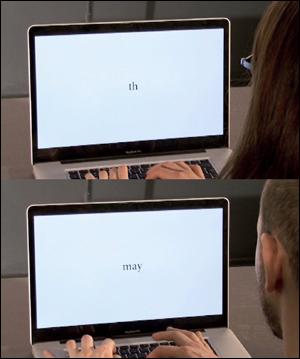

-
Punctuation?
by Nicolas Myers (opens in new tab)
There is a rich world of symbols that can change our perception of the written language. Never pronounced, constantly evolving, these seemingly trivial hooks, dots and lines can clarify, structure or twist a text; they can also make us smile or ponder upon an intended meaning. But on our keyboards this diversity is reduced to the bare minimum. Let’s mix and merge these symbols and invent new ones!
Punctu.at (opens in new tab) is a tool to create, combine and share new punctuation marks and symbols. Using existing typographic shapes, this project explores how personal symbols can enrich and modify the meaning of a text.
Visit Punctu.at (opens in new tab).
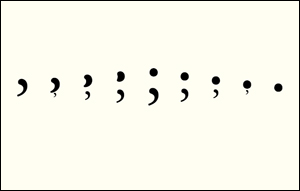
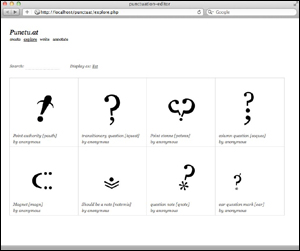
-
The Future of Everything
by Sascha Pohflepp (opens in new tab) and Chris Woebken (opens in new tab)
The future of writing is the future of writing down everything. We will be the last generation whose life will not have been on record. Personal technology has been tracking our every move for some time already and selective memory is a biological concept from which databases do not suffer. The future of writing will be our auto-autobiographies being created by machinic ghost-writers. How aware will we be of being the protagonist of a continuous narrative? One through which the past could be re-enacted, the meaning of the present influenced, and the future predicted.
The following are stills from three videos produced by Pohflepp and Woebken, entitled “Past”, “Present” and “Future”.
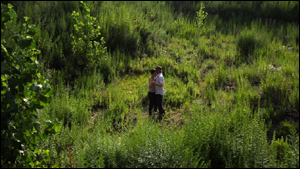
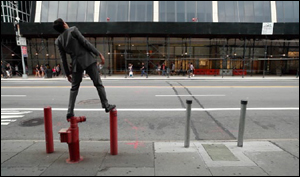
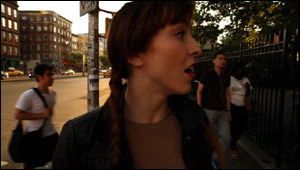
-
Thanks.
Huge thanks to Onkar Kular (opens in new tab) for his relentless mentorship and project management, and without whom this project would not have come to fruition. Thanks also to Jeremy Ettinghausen (opens in new tab), Tim Etchells (opens in new tab) and Justin McGuirk (opens in new tab) for their inspirational presentations and contributions at the opening workshop. Thanks, finally, to Kent Lowry of Microsoft Office for his support and contributions.

People
Richard Banks
Principal Design Manager

